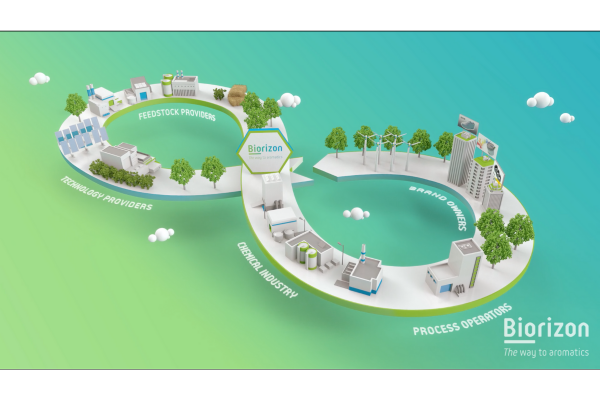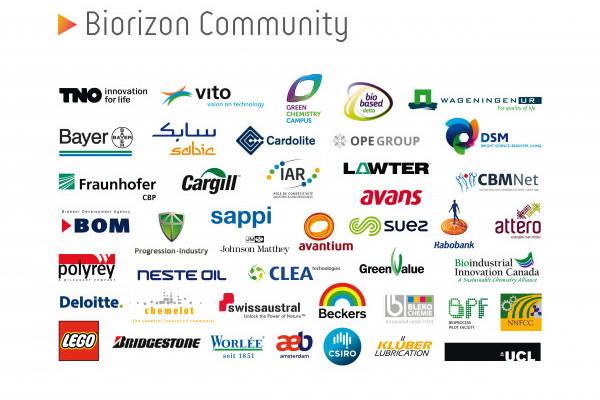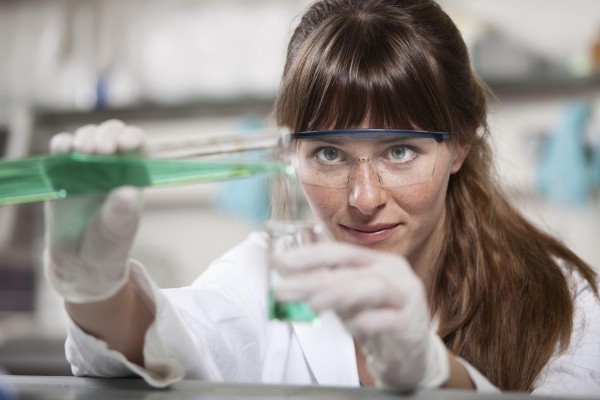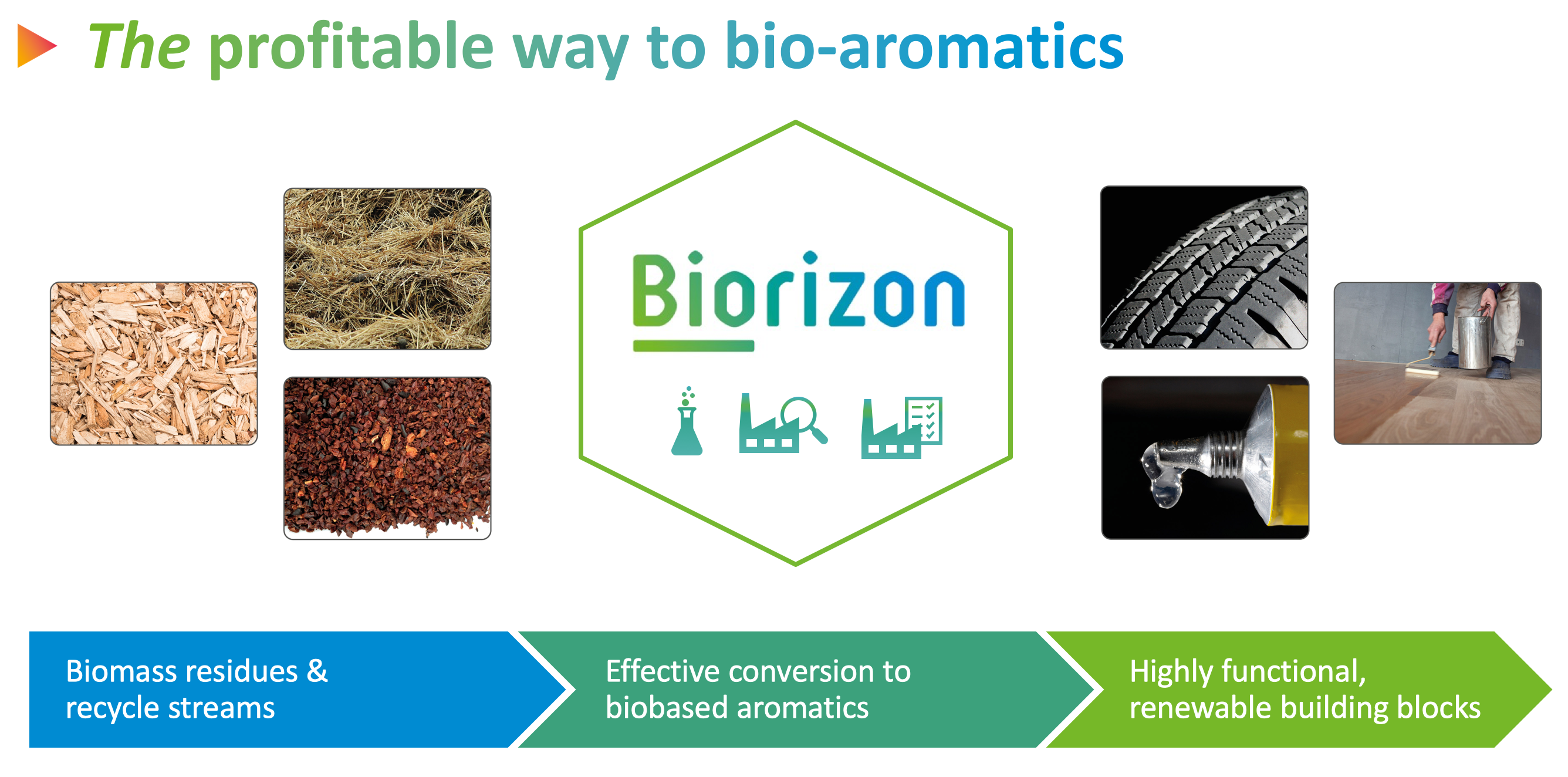News
03-12-2021
Event Report: Scaling up bio-aromatics research and application development with the industry
It was supposed to be a physical meeting place, but the 8th Biorizon Annual Event in Rotterdam turned out differently than expected. In front of 300 online followers, but in an empty conference room, the Biorizon team (and a speaker from LEGO) presented the progress in developing value chains for bio-aromatics. This development is progressing well.
Aromatics are common chemical building blocks, often for so-called 'performance products', such as plastics, coatings and resins. They are usually made from fossil raw materials. Through the Biorizon programme, research institutes TNO (the Netherlands) and VITO (Belgium) have been working with industry for eight years on developing and scaling up sustainable alternatives.
"It's about developing bio-aromatics from sugars or lignin, or via the thermochemical route. We leave fossil raw materials behind and go via new processes and chemistry to new, often better products from bio-based raw materials", is how host Joop Groen (director of Biorizon) summarised it.
The aim is to start commercial production in 2025. And that is going well, according to the results so far. Most of the studies have reached the pilot or demo phase and are already working with partners on application development. It has also already led to the founding of a first start-up: Relement, which started in 2020 and is commercially scaling up and marketing sugar-based bio-aromatics.
During the annual event, the managers of the three research directions or 'horizons' as they are called within Biorizon, explained the current state of affairs.
Thermochemical horizon
Jaap Kiel, manager of the Thermochemical horizon within Biorizon: "In our programme line, we first focus on the co-production of BTX during gasification of woody biomass or waste plastics. We also investigate the valorisation of lignin and lignin-rich biomass via thermochemical depolymerisation by pyrolysis, followed by fractionation via staged condensation." The research takes place at the Green Chemistry Campus in Bergen op Zoom and at TNO in Petten.
The result: green and circular BTX (benzene, toluene and xylene). These are building blocks for polyester production, among other things. Kiel: "This improves the business case for biomass gasification and we can also simplify downstream processing."
Kiel cited the international BIORECEPY project (https://www.biorizon.eu/projects/biorecepy-project-biomass-for-renewable-energy-and-chemicals-via-pyrolysis) as an example. In it, lignin from walnut shells and biorefineries is converted into applications such as biofuels for shipping and the production of car tyres and epoxy resins. The project is financially supported by the Dutch TKI Biobased Economy (TKI-BBE).
Lignin horizon
Whereas the thermochemical horizon mainly uses low-grade raw materials, the lignin horizon focuses on the catalytic depolymerisation of high-grade lignins. Manager Karolien VanBroekhoven: "There is not just one type of lignin, but a wide range from different manufacturers, with different properties and qualities. They are available as powders, extracts or oils, have different molecular weights and varying levels of carbohydrates or ash. Solubility in solvents also varies." The suitability for various applications therefore varies. That makes the research complex and challenging. That is why we have built a database in which we centralise all our knowledge and experience in this field and characterise all these different types of lignin. This in itself is extremely valuable.
"The aromatics we make from lignin cover the whole range from hard epoxy resins to elastomers and soft glues, all with their own applications," says VanBroekhoven. To speed up the process, several kilograms of samples have so far been produced for application development in a reactor at the German Fraunhofer Institute. Next year (2022), plenty of material should become available when the new LignoValue Pilot Plant at VITO in Mol (Belgium) becomes operational.
In the meantime, two projects have recently been started that will make use of bio-aromatics developed in the lignin horizon:
In the European LIFE VIABLE project, a sustainable alternative is being developed for BPA-based epoxy resin, which is used in composite materials for the automotive industry.
In the BBI JU-funded LIGNICOAT project, functional coatings based on lignin resins and biobased additives are being developed. They should lead to improved fire safety, corrosion resistance and biological resistance.
Sugar Horizon
Within the sugar horizon, a platform has been developed for the efficient production of bio-aromatics from furfural, extracted from hemicellulose, a residual flow from biorefineries. A first product, MPA, is currently being commercialised by the start-up Relement, which was established in late 2020.
"We are now working on a new generation of furan-based bioaromatics and a development platform for biophenol," says Paul Könst, manager of the sugar horizon. "By 2022 we expect to be able to deliver the first user samples with these."
Work is also underway on furan products that can be used directly in products. Könst expects to start working with a large, but unnamed consumer product manufacturer next year, who wants to actually apply the new furanic building blocks.
Also interesting is the collaboration in the new BRIGHT COATINGS project. The aim is to create a local value chain for the production of a 100% biobased alkyd coating. Companies like Cosun Beet Company, Vertoro and Lenzing supply hemicellulose for this purpose. Relement turns it into bio-aromatics on a 100 kilogram scale. Raw material supplier Worlée and paint producer Baril turn it into an alkyd resin that will then be used by Straalbedrijf Boxtel as surface protection for a front loader, a construction machine that will be used to study how the coating behaves in practice.
Toys
A company that has been working for years on making its products more sustainable is LEGO. Nelleke van der Puil, Vice President Materials of LEGO, summed up the commitments of this toy manufacturer in her key-note speech during the Biorizon event. For example, all LEGO bricks must be made of sustainable materials by 2030. Packaging must be sustainable and fully recyclable by 2025. CO2 emissions must be reduced by 37% by 2032.
Circularity will be the standard. And biobased raw materials will be "super important" to achieve sustainable growth. Not so much because consumers want it. LEGO research even shows that consumers do not care whether their LEGO blocks are of biobased origin. However, they do expect manufacturers to make sustainable products and that is why LEGO is experimenting with bioplastics as well as with recycling and reuse. "The properties of those materials are very important, because you don't just make a LEGO block. It has to be strong, safe, keep its shape and look attractive."
In 2018, for example, LEGO launched 'botanicals' (cubes in the shape of trees and bushes, ed.) made of bio-PE. Consumers reacted positively to that. "We are now going to expand the use of bio-PE to other elements as well. But we don't want to commit to one solution. We want to test several options and gain experience with them."
In practice, it means looking at PLA, r-PET, ABS with recycled content, PEF and other plastics. "We want to learn how to work with these materials, design moulds, control the conditions in the production environment and test different machine configurations. So there are still many questions we need to answer before we put new materials into mass production. But what is clear is that the circular value chain offers great opportunities for LEGO products, biobased polymers are a vital part of that."
Future
"There is momentum for the circular and biobased transition," concluded Joop Groen in his closing remarks. "And we have seen in the presentations that a lot of progress is being made. We owe this, among other things, to the good cooperation, the fantastic facilities, a team of experts, the involvement of the entire value chain for aromatics, the fact that we are working on drop-ins as well as new bio-aromatics and the more than 500 members of the Biorizon Community."
Biorizon's future therefore looks bright. "We now have a modest Biorizon Application Center on the Green Chemistry Campus. We want to expand that to work even more intensively with the industry on applications. We also want to focus more on research into circular aromatics. We think we can offer added value there. In both activities, we will work more intensively with the industry. That is possible now that our samples are growing. But let's not forget that we are doing this in the first place to give our children a healthier and safer future."
Missed the Biorizon Annual Event? Watch it now on Biorizon's YouTube channel.
Source: Agro & Chemistry in cooperation with Circular Biobased Delta










